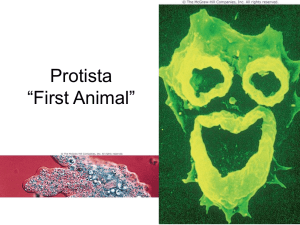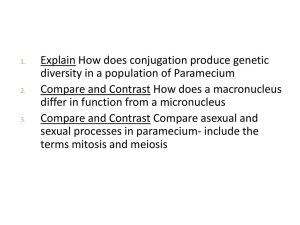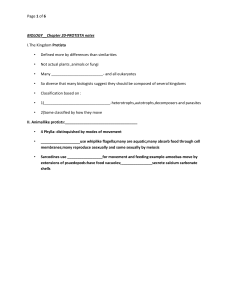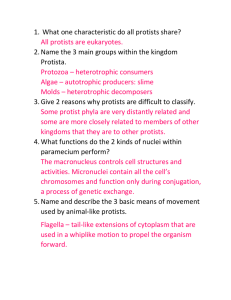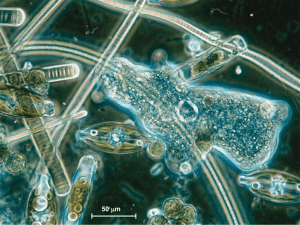Protista “First Animal”
advertisement
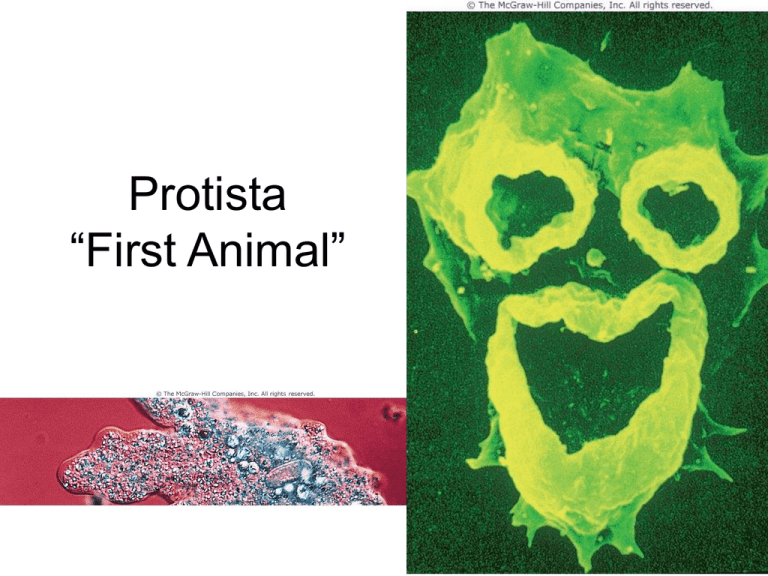
Protista “First Animal” • Overview: A World in a Drop of Water • Even a low-power microscope – Can reveal an astonishing menagerie of organisms in a drop of pond water M o v i e 50 m • Protista- single or colonies of eukaryotic cells (Ameoba, Paramecium) Animal-Like Protists: The Protozoa Unicellular and Colonial Eukaryotes These amazing organisms Belong to the diverse kingdoms of mostly singlecelled eukaryotes informally known as protists Animal-Like Protists Cladogram of Protozoa Relationships Relationship of Protists to animal • Protists, the most nutritionally diverse of all eukaryotes, include – Photoautotrophs, which contain chloroplasts – Heterotrophs, which absorb organic molecules or ingest larger food particles – Mixotrophs, which combine photosynthesis and heterotrophic nutrition Figure 8.3 • Protist habitats are also diverse in habitat • And including freshwater and marine species (a) The freshwater ciliate Stentor, a unicellular protozoan (LM) Stentor 100 m 100 m 4 cm (c) (b) Ceratium tripos, a unicellular marine dinoflagellate (LM) Delesseria sanguinea, a multicellular marine red alga 500 m (d) Spirogyra, a filamentous freshwater green alga (inset LM) • A sample of protist diversity • Diversity of plastids produced by secondary endosymbiosis Plastid Alveolates Dinoflagellates Apicomplexans Secondary endosymbiosis Cyanobacterium Ciliates Red algae Primary endosymbiosis Stramenopiles Heterotrophic eukaryote Plastid Euglenids Secondary endosymbiosis Green algae Figure 28.3 Chlorarachniophytes Figure 28.4 Diplomonadida Apicomplexans Ancestral eukaryote Plants Charophyceans (Opisthokonta) Chlorophytes Red algae Metazoans Choanoflagellates Amoebozoa Fungi Cellular slime molds Plasmodial slime molds Entamoebas Gymnamoebas Plantae Chlorophyta Rhodophyta Animalia Fungi Radiolarians Radiolaria Cercozoa Stramenopila Foraminiferans Chlorarachniophytes Brown algae Golden algae Diatoms Oomycetes Ciliates Euglenozoa Alveolata Dinoflagellates Euglenids Kinetoplastids Parabasalids Parabasala Diplomonads • Diplomonads and parabasalids have modified mitochondria • A tentative phylogeny of eukaryotes – Divides eukaryotes into many clades (Viridiplantae) • Diplomonads and parabasalids – Are adapted to anaerobic environments – Lack plastids – Have mitochondria that lack DNA, an electron transport chain, or citric-acid cycle enzymes Diplomonads • Diplomonads – Have two nuclei and multiple flagella Parabasalids • Parabasalids include trichomonads – Which move by means of flagella and an undulating part of the plasma membrane Flagella Undulating membrane 5 µm Figure 28.5b (b) Trichomonas vaginalis, a parabasalid (colorized SEM) • Euglenozoans have flagella with a unique internal structure • Euglenozoa is a diverse clade that includes – Predatory heterotrophs, photosynthetic autotrophs, and pathogenic parasites • The main feature that distinguishes protists in this clade – Is the presence of a spiral or crystalline rod of unknown function inside their flagella Flagella 0.2 µm Crystalline rod Figure 28.6 Ring of microtubules Subphylum Kinetoplasta • Kinetoplastids – Have a single, large mitochondrion that contains an organized mass of DNA called a kinetoplast – Include free-living consumers of bacteria in freshwater, marine, and moist terrestrial ecosystems Class Trypanosomatidea • The parasitic kinetoplastid Trypanosoma – Causes sleeping sickness in humans 9 m Copyright © The McGraw-Hill Companies, Inc. Permission required for reproduction or display. Life Cycle of Trypanosoma Brucei Fig. 8.9 8-6 Figure 8.8 (b) Super Phylum Sarcomastigophora • Chars: Flagella, pseudopodia, or both; single type of nucleus; no spores formed. • Subphylum Mastigophora – Chars: One or more Flagella – Autotrophic (cl. Phytomastigophora) – Heterotrophic (cl. Zoomastigophora) or both; – Reproduction usually by fission Copyright © The McGraw-Hill Companies, Inc. Permission required for reproduction or display. Structure of Euglena Fig. 8.7 Also classified as Phylum Euglenozoa Subphylum Euglenida Cl. Euglenoidea Subphylum Mastigophora (cl. Phytomastigophora) 8-4 Subphylum Euglenida • Euglenids – Have one or two flagella that emerge from a pocket at one end of the cell – Store the glucose polymer paramylon Long flagellum Eyespot: pigmented organelle that functions as a light shield, allowing light from only a certain direction to strike the light detector Light detector: swelling near the base of the long flagellum; detects light that is not blocked by the eyespot; as a result, Euglena moves toward light of appropriate intensity, an important adaptation that enhances photosynthesis Short flagellum Euglena (LM) Nucleus Contractile vacuole 5 µm Plasma membrane Figure 28.8 Pellicle: protein bands beneath the plasma membrane that provide strength and flexibility (Euglena lacks a cell wall) Chloroplast Paramylon granule Figure 8.6 Phylum Dinozoa: Dinoflagellates Phylum Dinozoa • Dinoflagellates – Are a diverse group of aquatic photoautotrophs and heterotrophs – Are abundant components of both marine and freshwater phytoplankton • Each has a characteristic shape – That in many species is reinforced by internal plates of cellulose • Two flagella – Make them spin as they move through the water Flagella Figure 28.10 • Rapid growth of some dinoflagellates – Is responsible for causing “red tides,” which can be toxic to humans Phylum Apicomplexa • Chars: All parasites • Apical complex used for penetrating host cells • Lack cilia and flagella, except in certain reproductive stages • Coccidians or apicomplexans are named based upon the presence of apical complex Apicomplexans • Apicomplexans – Are parasites of animals and some cause serious human diseases – Are so named because one end, the apex, contains a complex of organelles specialized for penetrating host cells and tissues – Have a nonphotosynthetic plastid, the apicoplast Ampicomplexan is an Alveolate • Alveolates have sacs beneath the plasma membrane- plasmodium, also seen in other phylums i.e. paramecium and stentor • Members of the clade Alveolata – Have membrane-bounded sacs (alveoli) just Alveoli 0.2 µm under the plasma membrane Flagellum Figure 28.9 Most important Coccidians are members of the class Sporozoea • Chars: intracellular parasites of animals • Form spores or oocysts following sexual reproduction • Complex life cycle that involve both vertebrate and invertebrate hosts • Example- Cl. Coccidea Plasmodium the sporozoan that causes malaria. • Most apicomplexans have intricate life cycles – With both sexual and asexual stages that often require two or more different host species for completion 2 The sporozoites enter the person’s liver cells. After several days, the sporozoites undergo multiple divisions and become merozoites, which use their apical complex to penetrate red blood cells (see TEM below). 1 An infected Anopheles mosquito bites a person, injecting Plasmodium sporozoites in its saliva. Inside mosquito Inside human Sporozoites (n) 7 An oocyst develops from the zygote in the wall of the mosquito’s gut. The oocyst releases thousands of sporozoites, which migrate to the mosquito’s salivary gland. Merozoite Liver Liver cell Apex Oocyst MEIOSIS Zygote (2n) Red blood cell Merozoite (n) Red blood cells FERTILIZATION Gametes Key 3 The merozoites divide asexually inside the red blood cells. At intervals of 48 or 72 hours (depending on the species), large numbers of merozoites break out of the blood cells, causing periodic chills and fever. Some of the merozoites infect new red blood cells. Gametocytes (n) Haploid (n) Diploid (2n) Figure 28.11 0.5 µm 4 Some merozoites form gametocytes. 6 Gametes form from gametocytes. Fertilization occurs in the mosquito’s digestive tract, and a zygote forms. The zygote is the only diploid stage in the life cycle. 5 Another Anopheles mosquito bites the infected person and picks up Plasmodium gametocytes along with blood. Copyright © The McGraw-Hill Companies, Inc. Permission required for reproduction or display. Life Cycle of Plasmodium Phylum Ciliophora • Chars: Cilia, macronuclei, and micronuclei usually present • Ciliates are the largest most complex and diverse group of the protozoans • Nearly occupy all aquatic habitats • Some are symbiotic • Reproduction can be asexual through fission or sexual through conjugation Ciliates • Ciliates, a large varied group of protists – Are named for their use of cilia to move and feed – Have large macronuclei and small micronuclei Example of a Ciliophora: Paramecium • Common freshwater ciliate • Observe live sample using methylcellulose solution • Other Ciliophora: Colpidium, Vorticella and Stentor • Exploring structure and function in a ciliate FEEDING, WASTE REMOVAL, AND WATER BALANCE Paramecium, like other freshwater protists, constantly takes in water by osmosis from the hypotonic environment. Bladderlike contractile vacuoles accumulate excess water from radial canals and periodically expel it through the plasma membrane. Contractile Vacuole Paramecium feeds mainly on bacteria. Rows of cilia along a funnel-shaped oral groove move food into the cell mouth, where the food is engulfed into food vacuoles by phagocytosis. Oral groove Cell mouth 50 µm Thousands of cilia cover the surface of Paramecium. Micronucleus Food vacuoles combine with lysosomes. As the food is digested, the vacuoles follow a looping path through the cell. Macronucleus Figure 28.12 The undigested contents of food vacuoles are released when the vacuoles fuse with a specialized region of the plasma membrane that functions as an anal pore. CONJUGATION AND REPRODUCTION 2 1 Two cells of compatible mating strains align side by side and partially fuse. 2 Meiosis of micronuclei produces four haploid MEIOSIS micronuclei in each cell. 3 Three micronuclei in each cell disintegrate. The remaining micronucleus in each cell divides by mitosis. Macronucleus Compatible mates 4 The cells swap one micronucleus. Haploid micronucleus Diploid micronucleus Diploid micronucleus MICRONUCLEAR FUSION 5 9 Two rounds of cytokinesis partition one macronucleus and one micronucleus into each of four daughter cells. 8 7 8 The original macronucleus disintegrates. Four micronuclei become macronuclei, while the other four remain micronuclei. 7 Three rounds of mitosis without cytokinesis produce eight micronuclei. 6 Micronuclei fuse, forming a diploid micronucleus. The cells separate. Key Conjugation Reproduction Asexual Reproduction in Protozoa - ciliophora Binary Fission of Ciliated Stentor Stentor ciliophora • Stramenopiles have “hairy” and smooth flagella • The clade Stramenopila – Includes several groups of heterotrophs as well as certain groups of algae • Most stramenopiles – Have a “hairy” flagellum paired with a “smooth” flagellum Hairy flagellum Smooth flagellum Figure 28.13 5 µm Diatoms • Diatoms are unicellular algae – With a unique two-part, glass-like wall of hydrated silica Figure 28.15 • Diatoms are a major component of phytoplankton – And are highly diverse Figure 28.16 50 µm • Most golden algae are unicellular – But some are colonial 25 µm Figure 28.17 • Brown algae – Include many of the species commonly called seaweeds • Seaweeds – Have the most complex multicellular anatomy of all algae Blade Stipe Figure 28.18 Holdfast Phylum Granuloreticulosa • Cl. Foraminiferans, or forams – Are named for their porous, generally multichambered shells, called tests 20 µm • Pseudopodia extend through the pores in the test • Foram tests in marine sediments – Form an extensive fossil record Radiolarians • Radiolarians are marine protists – Whose tests are fused into one delicate piece, which is generally made of silica – That phagocytose microorganisms with their pseudopodia • The pseudopodia of radiolarians, known as axopodia – Radiate from the central body Axopodia Figure 28.23 200 µm • Amoebozoans have lobe-shaped pseudopodia • Amoebozoans – Are amoeba that have lobe-shaped, rather than threadlike, pseudopodia – Include gymnamoebas, entamoebas, and slime molds Gymnamoebas • Gymnamoebas – Are common unicellular amoebozoans in soil as well as freshwater and marine environments Pseudopodia 40 µm Figure 28.24 Copyright © The McGraw-Hill Companies, Inc. Permission required for reproduction or display. Variations in Pseudopodia Fig. 8.10 8-7 Copyright © The McGraw-Hill Companies, Inc. Permission required for reproduction or display. Subphylum Sarcodina: Superclass Rhizopoda, Class Lobosea Fig. 8.11b 8-8 Other Sarcodina-“Not naked” sarcodines • Arcella, Difflugia, and Actinospaerium and marine radiolarians and foraminifera form test. • Test can be formed from sand grains, calcium carbonate and silica Copyright © The McGraw-Hill Companies, Inc. Permission required for reproduction or display. Freshwater Amoeba (Difflugia Oblongata) Fig. 8.12 8-9 Chlorophyta • Green algae – Are named for their grass-green chloroplasts – Are divided into two main groups: chlorophytes and charophyceans – Are closely related to land plants • Red algae and green algae are the closest relatives of land plants • Over a billion years ago, a heterotrophic protist acquired a cyanobacterial endosymbiont – And the photosynthetic descendants of this ancient protist evolved into red algae and green algae Endosymbiosis in Eukaryotic Evolution • Chlorophytes include – Unicellular, colonial, and multicellular forms 20 µm 50 µm (a) (b) Volvox, a colonial freshwater chlorophyte. The colony is a hollow ball whose wall is composed of hundreds or thousands of biflagellated cells (see inset LM) embedded in a gelatinous matrix. The cells are usually connected by strands of cytoplasm; if isolated, these cells cannot reproduce. The large colonies seen here will eventually release the small “daughter” colonies within them (LM). Caulerpa, an intertidal chlorophyte. The branched filaments lack cross-walls and thus are multinucleate. In effect, the thallus is one huge “supercell.” Figure 28.30a–c (c) Ulva, or sea lettuce. This edible seaweed has a multicellular thallus differentiated into leaflike blades and a rootlike holdfast that anchors the alga against turbulent waves and tides. Volvox, A Colonial Flagellate Fig. 8.8 Volvox Volvox 8-5 • Most chlorophytes have complex life cycles – With both sexual and asexual reproductive stages 7 These daughter cells develop flagella and cell walls and then emerge as swimming zoospores from the wall of the parent cell that had enclosed them. The zoospores grow into mature haploid cells, completing the asexual life cycle. Flagella 1 In Chlamydomonas, mature cells are haploid and contain a single cup-shaped chloroplast (see TEM at left). 2 In response to a shortage of nutrients, drying of the pond, or some other stress, cells develop into gametes. 3 Gametes of opposite mating types (designated + and –) pair off and cling together. Fusion of the gametes (syngamy) forms a diploid zygote. 1 µm Cell wall + Nucleus + Zoospores Regions of single chloroplast ASEXUAL REPRODUCTION Mature cell (n) SEXUAL REPRODUCTION + Key Haploid (n) Diploid (2n) Figure 28.31 + 6 When a mature cell reproduces asexually, it resorbs its flagella and then undergoes two rounds of mitosis, forming four cells (more in some species). SYNGAMY Zygote (2n) MEIOSIS 4 The zygote secretes a durable coat that protects the cell against harsh conditions. 5 After a dormant period, meiosis produces four haploid individuals (two of each mating type) that emerge from the coat and develop into mature cells.

